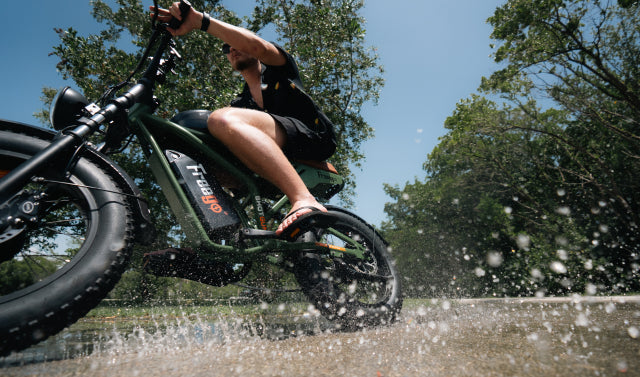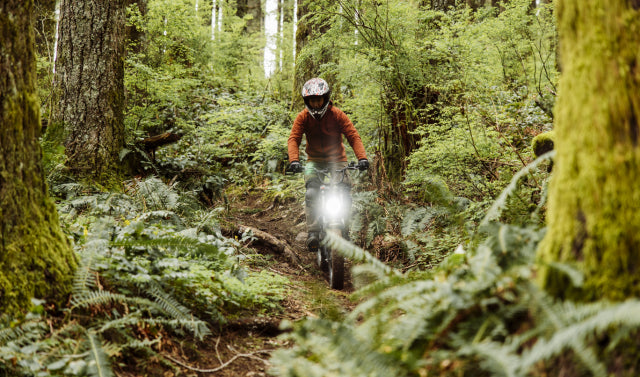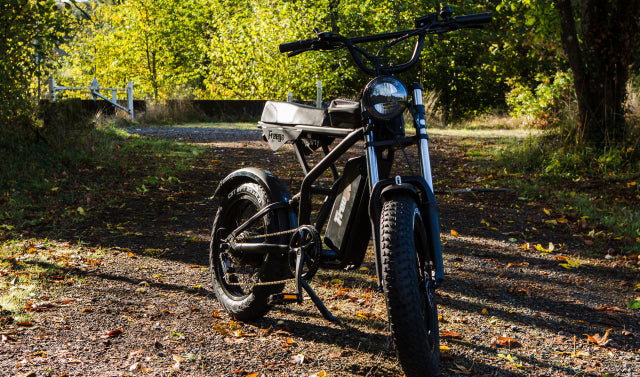Electric Bicycle FAQ: Your Questions Answered About E-Bikes
Electric Bicycle FAQ
General Information
1. Q: What is an electric bicycle?
A: An electric bicycle (e-bike) is a bicycle equipped with an electric motor to assist with propulsion. E-bikes typically include features such as pedal assist, throttle control, and rechargeable batteries, enhancing the riding experience by making it easier to travel longer distances and tackle hills.
2. Q: How does an electric bicycle work?
A: Electric bicycles combine traditional bicycle mechanics with an electric motor. The motor assists the rider based on their pedaling input, making it easier to ride uphill or against the wind. Most e-bikes offer different modes (e.g., Eco, Sport) that allow riders to select their preferred level of assistance.
Types of Electric Bicycles
3. Q: What types of electric bicycles are available?
A: Electric bicycles come in several types, including:
City/Commuter E-Bikes: Designed for urban commuting with features like fenders, lights, and comfortable seating.
Mountain E-Bikes: Built for off-road trails with sturdy frames, suspension systems, and wider tires.
Folding E-Bikes: Compact designs that can be folded for easy storage and transport, ideal for city dwellers.
Cargo E-Bikes: Equipped to carry heavy loads or passengers, often featuring larger frames and additional storage options.
Hybrid E-Bikes: Combining road and mountain bike features, suitable for various terrains.
Performance and Specifications
4. Q: What are the key specifications to consider when choosing an electric bicycle?
A: Important specifications include:
Motor Power: Measured in watts (W), typically ranging from 250W to 1500W or more. Higher wattage generally translates to more power for climbing hills.
Battery Capacity: Measured in amp-hours (Ah) or watt-hours (Wh), indicating how long the battery lasts on a full charge. A higher capacity allows for longer rides.
Range: The distance an e-bike can travel on a single charge, which varies based on the battery, terrain, and riding conditions.
Weight: The total weight of the bike affects handling and portability.
Top Speed: E-bikes are classified into different classes based on their maximum speeds, with regulations in some regions.
Maintenance and Care
5. Q: How do I maintain my electric bicycle?
A: Regular maintenance is essential for the longevity and performance of your e-bike:
Battery Care: Charge regularly and store the battery in a cool, dry place. Avoid complete discharges.
Tire Maintenance: Check tire pressure and inspect for wear or damage.
Brake Inspection: Ensure brakes are functioning correctly and adjust as necessary.
Cleaning: Clean the frame and components regularly, avoiding high-pressure water that can damage electrical components.
Professional Servicing: Schedule regular check-ups with a professional mechanic experienced in electric bicycles.
6. Q: How long do electric bicycle batteries last?
A: The lifespan of an electric bicycle battery varies based on usage, storage conditions, and care. Most lithium-ion batteries last between 2 to 5 years or approximately 500 to 1,000 charge cycles. Proper maintenance can significantly extend battery life.
Safety and Regulations
7. Q: Are electric bicycles safe to ride?
A: Yes, electric bicycles are generally safe, provided users follow traffic rules, wear helmets, and use safety equipment. E-bike riders should also be aware of local laws regarding speed limits and where e-bikes are permitted.
8. Q: What are the regulations surrounding electric bicycles?
A: Regulations for e-bikes vary by region but typically fall into specific classes:
Class 1: Pedal-assist only, with no throttle, maximum speed of 20 mph.
Class 2: E-bikes with a throttle that can assist up to 20 mph.
Class 3: Pedal-assist only, allowing speeds up to 28 mph, often requiring a license or registration in certain areas.
Troubleshooting
Electric Bike Troubleshooting Guide: Overview
This troubleshooting guide is designed to help you quickly identify and resolve common issues that may occur with your electric bike. Follow this guide to ensure your bike stays in peak condition and any minor problems are addressed before they become major.
Power Issues
Problem: The bike won't power on.
Possible Causes:
- The battery may be discharged.
- Loose or disconnected wiring.
- Faulty power switch or controller.
Solution:
- Ensure the battery is charged.
- Check for loose connections, particularly at the battery and motor.
- Inspect the power switch and controller for defects.
Battery Performance
Problem: Reduced range or battery not charging.
Possible Causes:
- The battery may be aging or faulty.
- Charger malfunction.
- Environmental factors such as extreme cold or heat.
Solution:
- Check the battery health and replace if necessary.
- Test the charger or try a different one.
- Avoid charging or storing the bike in extreme temperatures.
Motor Issues
Problem: The motor is not working or makes unusual noises.
Possible Causes:
- Loose connections between the motor and controller.
- Damaged motor or controller.
- Excessive load or overheating.
Solution:
- Inspect and tighten any loose connections.
- Examine the motor and controller for damage.
- Allow the bike to cool down if it’s overheated.
Brake Problems
Problem: Brakes are not responsive or too tight.
Possible Causes:
- Worn brake pads.
- Misaligned brake calipers.
- Hydraulic or mechanical system issues.
Solution:
- Check and replace worn brake pads.
- Adjust the brake calipers for proper alignment.
- Inspect hydraulic or mechanical systems for leaks or damage.
Throttle/Assist Mode Malfunction
Problem: Throttle or pedal-assist mode is not functioning.
Possible Causes:
- Faulty throttle sensor or pedal-assist sensor.
- Connection issues between the sensors and controller.
Solution:
- Inspect and clean the throttle or pedal-assist sensor.
- Check for any loose or damaged wiring. You can replace a new one to test.
Display/Controls Issues
Problem: Display screen not working or incorrect data shown(Error code)
Possible Causes:
- Loose connections or faulty wiring.
Solution:
- Check the connections to the display.
- Perform a reset or update the bike’s software if available.
- Preventive Maintenance Tips
- Regularly inspect and clean your electric bike to prevent dirt buildup.
- Ensure all connections are secure, especially after extended rides or rough terrain.
- Store the bike in a cool, dry place to protect the battery and electronics.
How to start support from Freego?
Answer: Please follow these steps to get support:
Proof of Purchase: Provide your order number or an invoice with the order number so we can verify your purchase location.
Who Will Assist You:
Purchased from a local Physical store: please contact the store for support.
Purchasing it from our website, the Freego professional service team will assist you. We’ll diagnose the issue, send you the necessary parts, and you can replace the faulty parts yourself by simply unscrewing and swapping them out. If you’re unable to do this, you can ask a family member or friend to help, or visit a local e-bike repair shop. The typical cost for this service ranges from $30 to $100. Regardless of who performs the repair, you'll need the correct parts. If the damage is caused by misuse or accidents, you’ll need to purchase the replacement parts, as they are not covered under warranty. But don't worry—once the parts are replaced, your bike should function well for 3-5 years.
9. Q: My electric bicycle won’t turn on. What should I do?
A: Check the following:
- Ensure the battery is charged. Plug it into the charger and verify the indicator light shows it’s charging.
- Confirm the battery is securely connected to the bike.
- Check the power switch (if applicable) to make sure it’s turned on.
- Inspect the wiring and connectors for any visible damage.
10. Q: Why is my e-bike not providing assistance?
A: Possible causes include:
- The battery may be depleted; try charging it.
- The pedal assist system may be turned off or set to a low mode; adjust settings as needed.
- There might be an issue with the motor or sensor. Check for error codes on the display and consult the user manual for troubleshooting.
11. Q: What should I do if I experience a flat tire?
A: Follow these steps:
- Remove the wheel from the frame. For rear wheels, disengage the motor connection if applicable.
- Check the tire for punctures and replace the inner tube if necessary.
- Reinstall the wheel and ensure it’s secure before riding again.
12. Q: My brakes are not working properly. What can I check?
A: If your brakes are not functioning correctly:
1.Inspect the brake pads for wear. If they are worn down, replace them.
2.Check the brake cable for fraying or damage and replace if necessary.
3.Ensure the brake levers are engaging the brakes fully and adjust if needed.
13. Q: There is a strange noise coming from my motor. What should I do?
A: If you hear unusual sounds:
1.Stop riding immediately to prevent further damage.
2.Check for any loose parts or debris around the motor.
3.Consult a professional mechanic to inspect the motor and diagnose any issues.
Product Promotion
14. Q: Are there any current promotions for Freego electric bicycles?
A: Yes, we frequently offer promotions, discounts, and special deals on selected models. Visit our website or subscribe to our newsletter for the latest offers and exclusive discounts.
15. Q: How can I stay informed about future promotions?
A: You can stay informed by subscribing to our newsletter on our website. We also share promotions on our social media channels, so follow us for updates.
Exchanges and Returns
16. Q: What is Freego’s exchange policy?
A: If you receive a defective or damaged product, you may exchange it within 20 days of the purchase date. To initiate an exchange:
- Contact our customer service team to report the issue.
- Provide your order number and details about the item you wish to exchange.
- Follow the instructions provided by our team for returning the original item.
- We will deduct $200 for the original shipping, $100 for handling, and $100 for repackaging, totaling approximately $400. We may charge more cost if we found missing parts in the returned item.
17. Q: What is the return policy for Freego electric bicycles?
A: We offer a 20-day return policy on unused and unopened products. To return an item:
- Ensure the product is in its original packaging and condition.
- Contact our customer service team to obtain a return authorization.
- Ship the item back (at your own cost) to us with the return authorization number clearly marked on the package.
- We will deduct $200 for the original shipping, $100 for handling, and $100 for repackaging, totaling approximately $400.
18. Q: Are there any items that cannot be returned?
A: For hygiene and safety reasons, items such as helmets or other personal protective gear may not be returned once opened. Please check our website for a full list of non-returnable items.
Order Cancellations
19. Q: How can I cancel my order?
A: If you wish to cancel your order, please contact our customer service team as soon as possible. We can cancel orders that have not yet been processed for shipment. Provide your order number and request a cancellation.
20. Q: Can I cancel my order if my order has already been shipped?
A: If your order has already been shipped, we cannot accept a cancellation. Should you wish to return the item, you will be responsible for the return shipping cost. We will deduct $200 for the original shipping, $100 for handling, and $100 for repackaging, totaling approximately $400. Additionally, the buyer is responsible for shipping the item back to the Freego warehouse.
21. Q: Will I receive a refund if I cancel my order?
A: Yes, if your order is canceled before shipping, you will receive a refund to the original payment method. If the order has shipped and you return the item (at your own cost), your partial refund will be processed after we receive the returned product. We will deduct 400USD from your payment for repacking, inspection and the shipping cost we paid.
Customer Support
22. Q: How can I contact Freego for support or inquiries?
A: You can reach our customer service team through:
Email: support@freegobikes.com
Phone: 213-640-6875 (call or text)
Website: Visit our [Contact Us page] https://freegobikes.com/pages/contact-us for additional contact options.
23. Q: What should I do if I experience issues with my Freego bicycle?
A: If you encounter any problems, please contact our customer support team. We offer a six-month warranty on all products, covering defects and functionality issues. Our team will guide you through the warranty process and provide necessary support.
24. FAQ: How to Switch the X2 Pro from City Mode to Off-Road Mode
Q: How do I switch my X2 Pro from City Mode to Off-Road Mode?
Answer: The X2 Pro electric motorcycle is legally configured for city use when shipped, with a default top speed of 28 mph in City Mode. However, switching to Off-Road Mode allows the bike to reach a top speed of 50 mph. Follow these steps to make the switch:
1. Make sure the bike is powered off: The screen should be off (black), but ensure the battery switch is still turned on.
2. Hold the brake lever: This is the most important step. Grab and hold the left (or right) brake lever firmly. Do not release it during the entire process until instructed, or the switch will fail.
3. Turn on the bike: While still holding the brake lever, press and hold the Power button (the button with the power symbol) until the screen lights up, then release the button.
4. Wait 40 seconds: Continue holding the brake lever for an additional 40 seconds after the bike turns on. You can count the seconds to ensure accuracy.
5. Release the brake lever: After 40 seconds, release the brake lever. At this point, the bike will have switched to Off-Road Mode, and the top speed will increase to 50 mph.
Key Points to Remember:
• Start with the bike turned off: Always begin with the bike powered down.
• Keep the brake lever held: This is crucial. If you release the brake lever at any point before the 40 seconds are up, the process will fail, and you will need to restart.
25. Q: How do I switch back to City Mode?
Answer: To return to City Mode, simply follow the same steps as above. Once completed, the bike will revert to its city-legal top speed of 28 mph.
By following these instructions carefully, you can easily switch between City and Off-Road Modes. If you have any questions, feel free to reach out to our support team.
Important Notice on the Legal Use of the X2 Pro’s Modes
Because the X2 Pro looks like a motorcycle, it’s easy for people to mistakenly think it’s a high-powered electric motorcycle that isn’t street-legal. To avoid any confusion and ensure road compliance, we’ve equipped the X2 Pro with two distinct modes: City Mode and Off-Road Mode.
When you receive the X2 Pro, it’s set to City Mode by default for legal street use. In City Mode:
• The top speed is capped at 28 mph.
• The motor power is limited to 750 watts.
• The bike includes pedals.
These features qualify the X2 Pro as a Class 3 e-bike, meaning it’s street-legal and complies with regulations. We want all our users to follow the law and avoid any issues.
When riding in urban areas or anywhere with regulations, stay in City Mode. You should only switch to Off-Road Mode when you’re in off-road settings, far from city limits, where rules don’t apply. Off-Road Mode allows you to unlock the full speed potential, but it’s meant for areas where it’s safe and legal to do so.
Switching between City and Off-Road Modes is simple and takes just about a minute. You can change modes as needed, but we urge you to use this feature responsibly and follow local laws to avoid unnecessary trouble.
We hope you enjoy your X2 Pro and have a great riding experience! Stay safe and ride smart!
Conclusion
If you have further questions or need additional information about Freego electric bicycles, please feel free to reach out to us. We are dedicated to helping you find the right e-bike that suits your lifestyle and needs.
This expanded FAQ now includes sections for Product Promotion, Exchanges and Returns, and Order Cancellations. If you need any more adjustments or additional information, just let me know!



